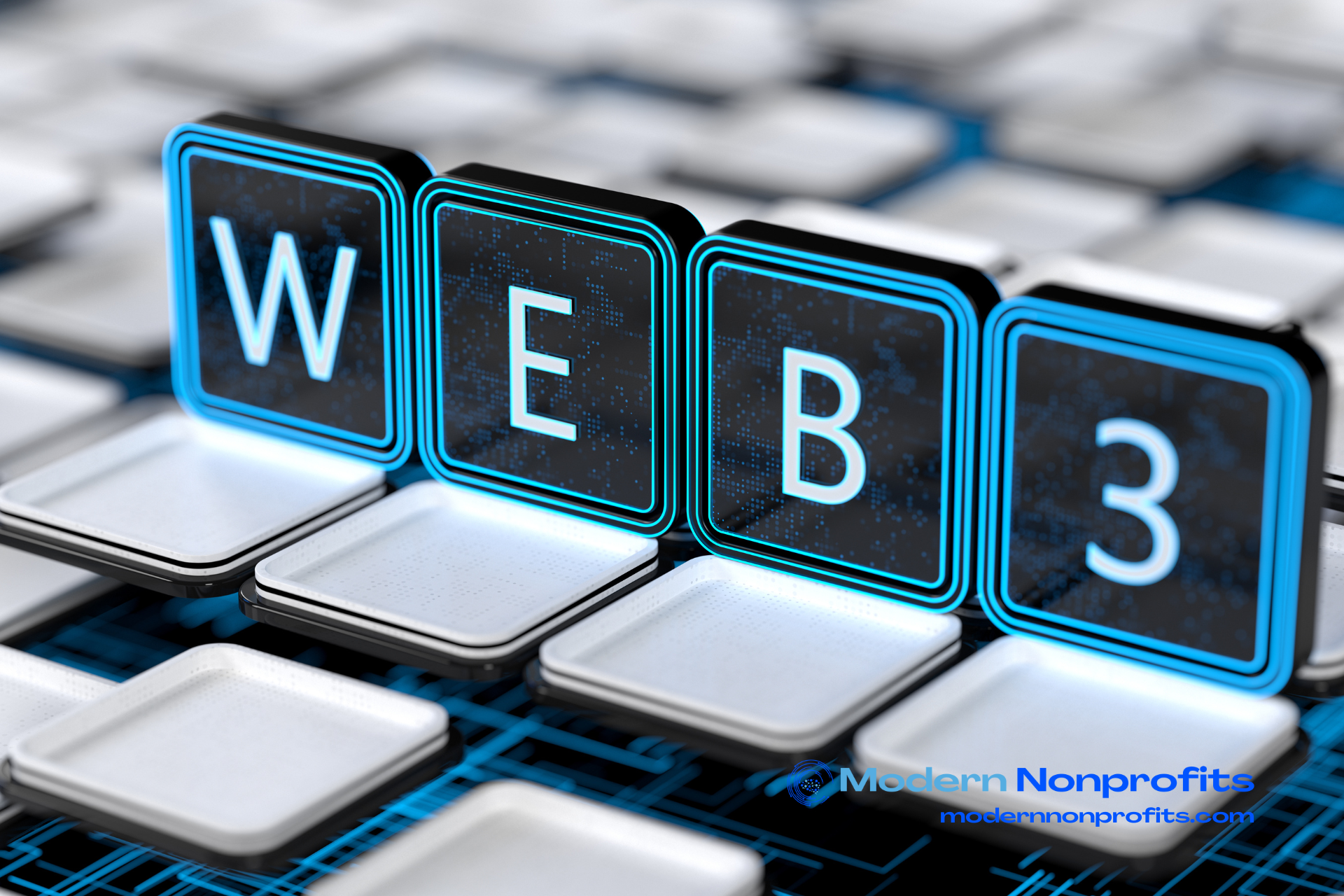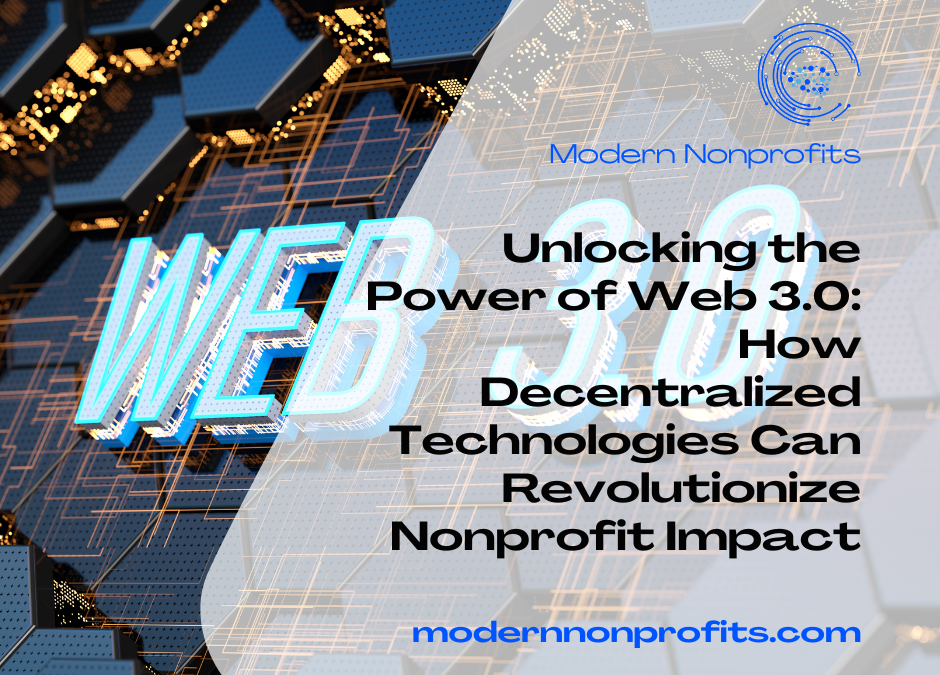In recent years, Web 3.0 has emerged as a new paradigm of the internet, promising to transform the way we interact with information, services, and each other. Built on decentralized technologies like blockchain, Web 3.0 offers a range of benefits for the third sector, including greater security, transparency, and accountability; lower costs and increased efficiency; global reach; innovation; and decentralized governance. In this post, we will explore the different ways Web 3.0 can benefit nonprofits and help them achieve their mission. We will examine the specific applications of Web 3.0, including decentralized social networks, marketplaces, finance, and storage, and how they can be leveraged by nonprofits. By the end of this post, you will have a better understanding of how Web 3.0 can help nonprofits make a positive impact on the world.

Web 3.0: The Future of the Internet
The internet has come a long way since its inception in the late 20th century. With each passing year, the internet has evolved, becoming more sophisticated and more advanced. Today, we are on the brink of a new era of the internet: Web 3.0. This new version of the internet promises to be more powerful, more secure, and more decentralized than ever before. In this article, we’ll take a closer look at what Web 3.0 is, and what it means for the future of the internet.
What is Web 3.0?
Web 3.0 is the next generation of the internet. While the first generation of the internet (Web 1.0) was primarily focused on providing static web pages, and the second generation (Web 2.0) focused on user-generated content and social interaction, Web 3.0 is all about decentralization and security.
At its core, Web 3.0 is a decentralized network of interconnected devices that allows for secure, peer-to-peer communication and transactions. Instead of relying on centralized servers to store and manage data, Web 3.0 uses blockchain technology to create a secure and decentralized network. This means that users can communicate and transact with each other directly, without the need for intermediaries like banks or social media companies.

What are the benefits of Web 3.0?
One of the key benefits of Web 3.0 is increased security. Because Web 3.0 is based on blockchain technology, data is stored in a decentralized and tamper-proof manner. This makes it much more difficult for hackers to access and steal data, as there is no central point of vulnerability.
Another benefit of Web 3.0 is increased privacy. With Web 2.0, companies like Google and Facebook collect vast amounts of personal data from their users. Web 3.0, on the other hand, is designed to give users more control over their data. Users can choose to store their data on the blockchain, where it is secured by encryption and distributed across the network.
Finally, Web 3.0 is more decentralized than previous versions of the internet. In Web 2.0, a small number of large companies like Google and Facebook dominated the internet. With Web 3.0, the power is distributed among a network of users and devices. This makes the internet more resilient to censorship and more resistant to the control of any one entity.

What are some examples of Web 3.0 applications?
There are already a number of exciting Web 3.0 applications in development. Here are a few examples:
- Decentralized social networks: Instead of relying on centralized platforms like Facebook or Twitter, Web 3.0 social networks allow users to communicate and share content directly with each other.
- Decentralized marketplaces: Web 3.0 marketplaces allow users to buy and sell goods and services without the need for intermediaries like Amazon or eBay.
- Decentralized finance (DeFi): DeFi platforms allow users to borrow, lend, and invest in a decentralized and secure manner.
- Decentralized storage: Web 3.0 storage solutions like IPFS allow users to store data in a decentralized and tamper-proof manner.
Web 3.0 represents a significant step forward in the evolution of the internet. By leveraging blockchain technology, Web 3.0 promises to be more secure, more private, and more decentralized than previous versions of the internet. As Web 3.0 applications continue to develop and gain popularity, we can expect to see a significant shift in the way we interact with the internet. The future of the internet is decentralized, secure, and peer-to-peer, and Web 3.0 is paving the way for this exciting new era.

One of the key features of Web 3.0 is its focus on trustlessness. Unlike Web 2.0, where users need to trust intermediaries like social media platforms and banks, Web 3.0 allows users to communicate and transact with each other directly. This not only makes the internet more secure but also reduces the need for intermediaries and the associated fees and potential for abuse.
However, there are still challenges that need to be addressed before Web 3.0 can reach its full potential. One of the biggest challenges is scalability. Blockchain technology can be slow and expensive, which can limit the number of transactions that can be processed on the network. To overcome this challenge, developers are working on solutions like sharding and layer 2 scaling solutions.
Another challenge is usability. Blockchain technology can be complex and difficult for the average user to understand and use. To address this challenge, developers are working on creating user-friendly interfaces that make it easier for users to interact with the blockchain.

Despite these challenges, Web 3.0 represents a significant shift in the way we think about and use the internet. With its focus on decentralization, security, and trustlessness, Web 3.0 has the potential to revolutionize not just the internet but also the way we interact with each other and with the world around us.
In conclusion, Web 3.0 is the future of the internet, and its potential is vast. From decentralized social networks to decentralized finance and marketplaces, Web 3.0 promises to be more secure, more private, and more decentralized than any version of the internet that has come before it. As Web 3.0 applications continue to develop and gain traction, we can expect to see a fundamental shift in the way we interact with the internet and with each other.

The Benefits of Web 3.0 for Nonprofits
Web 3.0 has the potential to benefit nonprofits in a number of ways. Here are some of the key benefits that nonprofits can expect from Web 3.0:
- Increased transparency: Web 3.0’s focus on decentralization and transparency makes it an ideal platform for nonprofits to share information about their operations and impact. With the use of blockchain technology, nonprofits can track and record every transaction and donation, providing greater transparency and accountability to donors and stakeholders.
- Enhanced security: With its focus on decentralization and cryptography, Web 3.0 provides a higher level of security for nonprofit organizations. By using blockchain technology to store and protect data, nonprofits can ensure that their sensitive information is safe from hackers and other malicious actors.
- Lower transaction fees: Web 3.0’s focus on eliminating intermediaries means that nonprofits can expect lower transaction fees when accepting donations and processing payments. This is particularly important for small nonprofits, which may have limited budgets for payment processing and other administrative costs.
- Faster and more efficient fundraising: With Web 3.0, nonprofits can leverage decentralized finance (DeFi) platforms to raise funds more efficiently and quickly. DeFi platforms allow for peer-to-peer transactions, eliminating the need for intermediaries like banks and payment processors.
- Increased access to funding: Web 3.0’s focus on decentralization means that nonprofits can access funding from a wider range of sources. With crowdfunding platforms and other decentralized fundraising mechanisms, nonprofits can tap into a global network of donors and supporters.
- Improved governance: Web 3.0’s focus on transparency and decentralized decision-making can help improve governance within nonprofit organizations. By using blockchain technology to record and verify every decision, nonprofit organizations can ensure that their governance processes are transparent and accountable.
In conclusion, Web 3.0 has the potential to benefit nonprofit organizations in numerous ways. From increased transparency and security to lower transaction fees and more efficient fundraising, Web 3.0 can help nonprofits achieve their mission more effectively and efficiently. As Web 3.0 continues to evolve, nonprofit organizations should explore ways to leverage its potential to achieve their goals and make a positive impact on the world.

Web 3.0 offers several benefits for the third sector, including:
- Decentralization: Web 3.0 is built on decentralized technologies like blockchain, which offer greater security, transparency, and accountability. This can help nonprofits build trust with their stakeholders and ensure that their operations are transparent and ethical.
- Lower costs: Web 3.0 technologies like decentralized finance and decentralized storage can help nonprofits reduce their operating costs, freeing up resources that can be used to further their mission.
- Increased efficiency: Web 3.0 technologies can streamline operations, automate tasks, and provide real-time data, allowing nonprofits to make more informed decisions and operate more efficiently.
- Global reach: Web 3.0 technologies can help nonprofits reach a global audience, connecting them with supporters and partners from all over the world.
- Innovation: Web 3.0 is a rapidly evolving field that is constantly introducing new technologies and solutions. This can help nonprofits stay on the cutting edge of innovation and find new ways to achieve their mission.
- Decentralized governance: Web 3.0 technologies can facilitate decentralized decision-making within nonprofit organizations, making it easier for stakeholders to participate in the decision-making process and ensuring that governance processes are transparent and accountable.
In conclusion, Web 3.0 offers several benefits for the third sector, including greater security, transparency, and accountability; lower costs and increased efficiency; global reach; innovation; and decentralized governance. As Web 3.0 continues to evolve, nonprofit organizations should explore ways to leverage these technologies to achieve their goals and make a positive impact on the world.

How Decentralized Social Networks Work in Service of Nonprofits
- Community building: DSNs can help nonprofits build and grow their communities by providing a platform for supporters and donors to connect with each other and with the organization. DSNs can also facilitate peer-to-peer fundraising and other forms of engagement that help build a sense of community and shared purpose.
- Fundraising: DSNs can be used for crowdfunding campaigns and other fundraising initiatives. Nonprofits can use DSNs to solicit donations directly from supporters, without the need for intermediaries like banks or payment processors. This can help reduce transaction fees and increase the speed and efficiency of fundraising campaigns.
- Data sharing: DSNs can facilitate secure and decentralized data sharing between nonprofits and their supporters. By using blockchain technology, nonprofits can ensure that their data is secure and transparent, and that it is only accessible by authorized parties.
- Decentralized governance: DSNs can be used to facilitate decentralized decision-making within nonprofit organizations. By using blockchain technology to record and verify every decision, nonprofits can ensure that their governance processes are transparent and accountable.
- Increased privacy and security: DSNs offer increased privacy and security for nonprofits and their supporters. By using cryptography to protect user data and transactions, DSNs can help reduce the risk of hacking and other cyber attacks.
- Global reach: DSNs can help nonprofits reach a global audience, connecting them with supporters and donors from all over the world. This can help nonprofits expand their reach and increase their impact.
In conclusion, decentralized social networks have the potential to transform the way nonprofits operate, communicate, and fundraise. By providing a secure and decentralized platform for communication and data sharing, DSNs can help nonprofits build stronger communities, increase their reach, and achieve their mission more effectively. As Web 3.0 continues to evolve, nonprofit organizations should explore ways to leverage DSNs to achieve their goals and make a positive impact on the world.

How Decentralized Marketplaces Work in Service of Nonprofits
- Fundraising: DMs can be used to sell goods and services to raise funds for nonprofit organizations. Nonprofits can offer merchandise, tickets to events, or other products on the DM platform, and supporters can purchase them directly using cryptocurrency. This can help reduce transaction fees and increase the speed and efficiency of fundraising campaigns.
- Decentralized governance: DMs can be used to facilitate decentralized decision-making within nonprofit organizations. By using blockchain technology to record and verify every decision, nonprofits can ensure that their governance processes are transparent and accountable.
- Increased privacy and security: DMs offer increased privacy and security for nonprofits and their supporters. By using cryptography to protect user data and transactions, DMs can help reduce the risk of hacking and other cyber attacks.
- Access to a global market: DMs can help nonprofits reach a global audience, connecting them with supporters and buyers from all over the world. This can help nonprofits expand their reach and increase their impact.
- Lower transaction fees: DMs eliminate the need for intermediaries like banks and payment processors, which can help reduce transaction fees for nonprofits.
- Transparent supply chains: DMs can be used to create transparent supply chains for nonprofit organizations. By using blockchain technology to track and verify every transaction, nonprofits can ensure that their products are ethically sourced and produced.
In conclusion, decentralized marketplaces have the potential to transform the way nonprofits operate and raise funds. By providing a secure and decentralized platform for buying and selling goods and services, DMs can help nonprofits expand their reach, increase their impact, and achieve their mission more effectively. As Web 3.0 continues to evolve, nonprofit organizations should explore ways to leverage DMs to achieve their goals and make a positive impact on the world.

How Decentralized Finance (DeFi) Work in Service of Nonprofits
- Fundraising: DeFi can be used to raise funds for nonprofit organizations through crowdfunding campaigns and other initiatives. Nonprofits can create smart contracts on the blockchain that automatically release funds when certain conditions are met, such as reaching a fundraising goal.
- Transparent and secure financial transactions: DeFi offers transparent and secure financial transactions through the use of smart contracts and cryptography. This can help reduce the risk of fraud and ensure that transactions are transparent and accountable.
- Decentralized governance: DeFi can be used to facilitate decentralized decision-making within nonprofit organizations. By using blockchain technology to record and verify every decision, nonprofits can ensure that their governance processes are transparent and accountable.
- Lower transaction fees: DeFi eliminates the need for intermediaries like banks and payment processors, which can help reduce transaction fees for nonprofits.
- Investment opportunities: DeFi offers investment opportunities for nonprofits, allowing them to earn returns on their assets through lending, staking, and other mechanisms.
- Global reach: DeFi can help nonprofits reach a global audience, connecting them with supporters and investors from all over the world. This can help nonprofits expand their reach and increase their impact.
In conclusion, decentralized finance has the potential to transform the way nonprofits manage their finances and achieve their goals. By providing a secure and decentralized platform for financial transactions, DeFi can help nonprofits reduce transaction fees, increase transparency and accountability, and expand their reach. As Web 3.0 continues to evolve, nonprofit organizations should explore ways to leverage DeFi to achieve their goals and make a positive impact on the world.

How Decentralized Storage Work in Service of Nonprofits
- Secure and private data storage: Decentralized storage systems use encryption and cryptography to protect user data, making them more secure and private than traditional storage solutions. This can help nonprofits protect sensitive information, such as donor data and financial records.
- Resilience to cyber attacks: Decentralized storage systems are distributed across a network of computers, making them more resilient to cyber attacks. If one computer on the network is compromised, the rest of the network can still function normally.
- Lower storage costs: Decentralized storage systems can be more cost-effective than traditional storage solutions, as they eliminate the need for expensive hardware and maintenance.
- Access to a global network: Decentralized storage systems can help nonprofits store and access their data from anywhere in the world, connecting them with partners and supporters from all over the globe.
- Decentralized governance: Decentralized storage systems can be governed by a decentralized network of users, giving nonprofits more control over their data and how it is stored and managed.
- Transparency and accountability: Decentralized storage systems can provide a transparent and accountable record of all data transactions, helping nonprofits maintain accurate and up-to-date records.
In conclusion, decentralized storage has the potential to transform the way nonprofits store and manage their data. By providing a secure, resilient, and cost-effective storage solution, decentralized storage systems can help nonprofits protect sensitive information, reduce storage costs, and expand their reach. As Web 3.0 continues to evolve, nonprofit organizations should explore ways to leverage decentralized storage to achieve their goals and make a positive impact on the world.

Further Reading
Here you can find several books in order to deepen your knowledge in Web 3.0 and its contribution into making social impact:
- The Spatial Web: How web 3.0 will connect humans, machines and AI to transform the world by Gabriel René and Dan Mapes
- Blockchain 2035: The Digital DNA of Internet 3.0 by Jared Tate and Andrew Knapp
- Blockchain and Web 3.0 (Routledge Studies in Science, Technology and Society) by Massimo Ragnedda and Giuseppe Destefanis
- WEB3: What Is Web3? Potential of Web 3.0 (Token Economy, Smart Contracts, DApps, NFTs, Blockchains, GameFi, DeFi, Decentralized Web, Binance, Metaverse Projects, Web3.0 Metaverse Crypto guide, Axie) by Patrick Ejeke
- Navigating the Metaverse: A Guide to Limitless Possibilities in a Web 3.0 World by Cathy Hackl and Dirk Lueth
- WEB 3.0 FOR BEGINNERS: The Complete Step By Step Instructional Manual On How To Understand Web 3.0 (Smart Contracts, DApps, NFTs, Blockchains, DeFi, Decentralized Web, Metaverse) For Beginners by Blake Grant
- Blockchain Fundamentals for Web 3.0 by Mary C. Lacity and Steven C. Lupien

Conclusion
In conclusion, Web 3.0 represents a new frontier for the third sector, offering a range of exciting opportunities for nonprofits to achieve their mission more efficiently, effectively, and ethically. By leveraging decentralized technologies like blockchain, nonprofits can benefit from greater security, transparency, and accountability; lower costs and increased efficiency; global reach; innovation; and decentralized governance. The applications of Web 3.0, including decentralized social networks, marketplaces, finance, and storage, can provide nonprofits with powerful tools to connect with supporters, manage data, raise funds, and drive social impact. As Web 3.0 continues to evolve, it will be crucial for nonprofits to stay informed and explore ways to harness the potential of these technologies. By doing so, they can better navigate the challenges and opportunities of the digital age and make a positive difference in the world.



Thank you for the most informed article about Web 3.0. I never quite understood what exactly it was all about before, I just thought it was another upgrade of the internet. I never realized that Web 3.0 now uses blockchain technology, which will hopefully stop a lot of hackers in their tracks. Also, the web won’t be dominated by the likes of the giants like Facebook and Google only and will be distributed to other subsidiaries. Hopefully, we will also notice a lot of good changes down the line as the users of the internet.
Hi, a conclusion Web 3.0, with its decentralized architecture and trustless systems, has the potential to create a more secure, transparent, and equitable digital world. And now we all have to find a way to take advantage of those benefits and implement them in the most appropriate way for our needs. Like you explore the ways how to revolutionize nonprofit impact.
Thank you Anita.
Although web 2.0 had a lot of positives it also resulted in centralizing a lot of power and control in a few select entities. Google and Amazon are two very bright examples. I can see where things go with web 3.0 but I am curious how these big brands will react to such a decentralized scheme because obviously something like this will significantly hurt their businesses.
This is such an interesting topic! I’m really excited to learn more about how decentralized technologies can revolutionize nonprofit impact.
It’s amazing that web 3.0 has the potential to unlock so much power for non-profits and help them make a bigger difference in the world.
What are the potential risks associated with utilizing decentralized technologies for nonprofit impact?
How do we ensure that these new technologies are implemented in an ethical and responsible manner?
Thanks for an interesting article
Cheers
Matt H